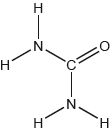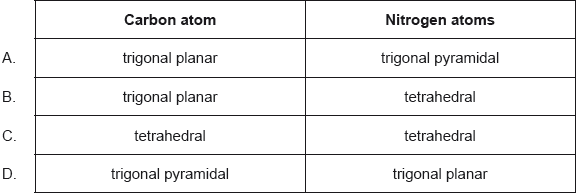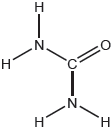DP Chemistry Questionbank

4.3 Covalent structures
Description
[N/A]Directly related questions
- 17M.1.hl.TZ1.12: Which combination describes the bonding and structure in benzoic acid, C6H5COOH?
- 17M.1.sl.TZ1.9: A substance has the following properties: What is the most probable structure of this...
- 17M.1.sl.TZ2.11: What are the approximate bond angles and structure of crystalline SiO2?
-
17M.2.hl.TZ1.5a:
Estimate the H−N−H bond angle in methanamine using VSEPR theory.
-
17N.2.hl.TZ0.4a:
Draw the Lewis (electron dot) structures of PF3 and PF5 and use the VSEPR theory to deduce the molecular geometry of each species including bond angles.
-
21M.2.sl.TZ1.2a(i):
Draw the Lewis (electron dot) structure of hydrogen sulfide.
- 18N.1.sl.TZ0.10: How many lone pairs and bonding pairs of electrons surround the central chlorine atom in...
-
22M.2.sl.TZ1.2b:
Draw the Lewis (electron dot) structure of the ammonia molecule.
-
19M.2.sl.TZ2.1b(i):
Deduce the Lewis (electron dot) structure of ethyne.
-
16N.2.hl.TZ0.2d:
Draw the Lewis (electron dot) structure of the ethanedioate ion, –OOCCOO–.
-
16N.2.sl.TZ0.2d:
The Lewis (electron dot) structure of the ethanedioate ion is shown below.
Outline why all the C–O bond lengths in the ethanedioate ion are the same length and suggest a value for them. Use section 10 of the data booklet.
-
17M.2.sl.TZ1.4a:
Estimate the H−N−H bond angle in methanamine using VSEPR theory.
-
17M.2.sl.TZ2.4b:
Deduce the Lewis (electron dot) structures of ozone.
-
17N.2.hl.TZ0.4b:
Predict whether the molecules PF3 and PF5 are polar or non-polar.
-
17N.2.sl.TZ0.3b:
Predict with a reason, whether the molecule PF3 is polar or non-polar.
-
21M.2.sl.TZ2.2c:
Deduce the Lewis (electron dot) structure and molecular geometry of sulfur dichloride, SCl2.
-
18M.3.sl.TZ2.1a.i:
Graphene is two-dimensional, rather than three-dimensional, material.
Justify this by using the structure of graphene and information from the table.
-
18M.3.sl.TZ2.1a.ii:
Show that graphene is over 1600 times stronger than graphite.
-
18M.3.sl.TZ2.1a.iii:
Identify a value from the table which can be used to support the information about graphene given below.

Electrons in a solid are restricted to certain ranges, or bands, of energy (vertical axis). In an insulator or semiconductor, an electron bound to an atom can break free only if it gets enough energy from heat or a passing photon to jump the “band gap”, but in graphene the gap is infinitely small.

- 21N.2.sl.TZ0.3b(i): Deduce the electron domain and molecular geometry using VSEPR theory, and estimate the Cl–P–Cl...
- 22M.2.sl.TZ2.3d(ii): Explain the electron domain geometry of NO3−.
- 19N.2.sl.TZ0.1b: Outline why both bonds in the ozone molecule are the same length and predict the bond length in...
-
17M.2.hl.TZ2.4b.ii:
Deduce one resonance structure of ozone and the corresponding formal charges on each oxygen atom.
- 20N.2.hl.TZ0.2a: Predict the electron domain and molecular geometries around the oxygen atom of molecule A using...
-
21M.2.hl.TZ1.7a(i):
Draw a Lewis (electron dot) structure for ozone.
-
18M.3.sl.TZ2.1b:
Diamond, graphene, and graphite are all network solids.
Suggest, giving a reason, the electron mobility of diamond compared to graphene.
- 21N.2.hl.TZ0.3b(i): Deduce the electron domain and molecular geometry using VSEPR theory, and estimate the Cl–P–Cl...
- 22M.2.sl.TZ2.3d(i): Draw the Lewis structure of NO3−.
- 22M.2.hl.TZ2.6c(i): Draw the Lewis structure of SO3.
-
19M.2.hl.TZ1.5c(iv):
State the type of bond formed when chloramine is protonated.
-
19M.2.hl.TZ1.5c(iii):
Deduce the molecular geometry of chloramine and estimate its H–N–H bond angle.
Molecular geometry:
H–N–H bond angle:
- 19N.2.sl.TZ0.1a: Draw the Lewis structures of oxygen, O2, and ozone, O3.
- 16N.1.sl.TZ0.9: Which pair of molecules has the same bond angles? A. PCl3 and BCl3 B. SO2 and CO2 C. H2O...
-
16N.3.sl.TZ0.6c:
(i) Suggest why incomplete combustion of plastic, such as polyvinyl chloride, is common in industrial and house fires.
(ii) Phthalate plasticizers such as DEHP, shown below, are frequently used in polyvinyl chloride.
With reference to bonding, suggest a reason why many adults have measurable levels of phthalates in their bodies.
- 16N.1.sl.TZ0.12: Which substance has a giant covalent structure?
- 17M.1.sl.TZ1.12: Which correctly states the strongest intermolecular forces in the compounds below?
-
17M.2.sl.TZ2.3b:
Deduce the Lewis (electron dot) structure and molecular geometry of PCl3.
-
18M.2.hl.TZ1.1b:
The structural formula of urea is shown.

Predict the electron domain and molecular geometries at the nitrogen and carbon atoms, applying the VSEPR theory.

-
18M.2.hl.TZ2.7e:
Carbon and silicon are elements in group 14.
Explain why CO2 is a gas but SiO2 is a solid at room temperature.
- 18M.1.sl.TZ1.10: Which form of carbon is the poorest electrical conductor? A. Graphite B. Graphene C. ...
- 21N.2.sl.TZ0.3b(ii): Explain the polarity of PCl3.
- 22M.1.sl.TZ1.11: Which molecule is most polar? A. CF4 B. CCl4 C. CHF3 D. CClF3
- 18N.2.hl.TZ0.3c: Predict, using the VSEPR theory, the geometry of the BrO3− ion and the O−Br−O bond angles.
-
22M.2.hl.TZ2.8a(i):
Outline two differences between the bonding of carbon atoms in C60 and diamond.
-
19M.2.hl.TZ1.5c(i):
Draw a Lewis (electron dot) structure of chloramine.
-
17M.2.hl.TZ1.5b:
State the electron domain geometry around the nitrogen atom and its hybridization in methanamine.
-
17M.1.sl.TZ1.11:
Which combination describes the sulfate(IV) ion, SO32– (also known as sulfite ion)?
-
20N.1.sl.TZ0.10:
Which molecule is most polar?
A.
B.
C.
D.
- 20N.2.sl.TZ0.2a: Predict the electron domain and molecular geometries around the oxygen atom of molecule A using...
-
18M.1.sl.TZ2.11:
What are the predicted electron domain geometries around the carbon and both nitrogen atoms in urea, (NH2)2CO, applying VSEPR theory?

-
21N.2.sl.TZ0.3a(i):
Sketch the Lewis (electron dot) structure of the P4 molecule, containing only single bonds.
-
21N.2.hl.TZ0.3a(i):
Sketch the Lewis (electron dot) structure of the P4 molecule, containing only single bonds.
- 18N.2.sl.TZ0.3c: Predict, using the VSEPR theory, the geometry of the BrO3− ion and the O−Br−O bond angles.
-
19M.2.hl.TZ2.3d(ii):
State, giving a reason, the shape of the dinitrogen monoxide molecule.
-
16N.2.hl.TZ0.2e:
Outline why all the C–O bond lengths in the ethanedioate ion are the same length and suggest a value for them. Use section 10 of the data booklet.
-
17M.2.hl.TZ1.5c:
Ammonia reacts reversibly with water.
Explain the effect of adding ions on the position of the equilibrium. - 21M.1.sl.TZ1.12: Along which series is the bond angle increasing? A. NH3 H2O CH4 B. CH4 NH3 H2O C. H2O ...
-
21M.2.hl.TZ2.2c:
Deduce the Lewis (electron dot) structure and molecular geometry of sulfur tetrafluoride, SF4, and sulfur dichloride, SCl2.
- 18M.1.sl.TZ1.11: What is the molecular geometry and bond angle in the molecular ion NO3−?
-
18M.2.sl.TZ1.1b:
The structural formula of urea is shown.

Predict the electron domain and molecular geometries at the nitrogen and carbon atoms, applying the VSEPR theory.

- 18M.1.sl.TZ2.10: Which species has the longest carbon to oxygen bond length? A. CO B. CH3OH C. ...
- 22M.1.sl.TZ1.12: For which species can resonance structures be drawn? A. HCOOH B. HCOO– C. CH3OH D. H2CO3
-
18N.2.sl.TZ0.3b:
Draw the Lewis (electron dot) structure for BrO3− that obeys the octet rule.
- 18N.2.hl.TZ0.8a: Suggest why the three-membered ring in methyloxirane is unstable.
-
18N.2.hl.TZ0.3b.i:
Draw two Lewis (electron dot) structures for BrO3−.
-
22M.2.hl.TZ1.6a(ii):
Deduce a Lewis (electron dot) structure of the nitric acid molecule, HNO3, that obeys the octet rule, showing any non-zero formal charges on the atoms.
-
17N.2.sl.TZ0.3a:
Draw the Lewis (electron dot) structures of PF3 and PF4+ and use the VSEPR theory to deduce the molecular geometry of each species.
- 21M.1.sl.TZ1.9: The Lewis structure of methylamine is shown. What is the molecular geometry around N? A. ...
- 21M.2.sl.TZ1.2a(ii): Predict the shape of the hydrogen sulfide molecule.
-
18M.3.sl.TZ2.1c:
The melting point of diamond at 1 × 106 kPa is 4200 K (in the absence of oxygen).
Suggest, based on molecular structure, why graphene has a higher melting point under these conditions.
- 18N.1.sl.TZ0.12: Which molecule is polar? A. BeCl2 B. BCl3 C. NCl3 D. CCl4
- 22M.1.hl.TZ1.13: What are the electron domain and molecular geometries of the XeF4 molecule?
-
22M.2.hl.TZ2.8a(ii):
Explain why C60 and diamond sublime at different temperatures and pressures.
- 19N.1.sl.TZ0.11: Which describes a resonance structure? A. Double bond can be drawn in alternative...
-
19N.1.sl.TZ0.12:
What is the structure and bonding in SiO2 (s)?
-
20N.1.sl.TZ0.11:
Which combination correctly describes the geometry of the carbonate ion, ?
-
18M.2.sl.TZ2.6b:
Lewis structures show electron domains and are used to predict molecular geometry.
Deduce the electron domain geometry and the molecular geometry for the NH2− ion.
- 18N.1.sl.TZ0.9: Which species has the same molecular geometry as SO32−? A. BF3 B. SO3 C. PF3 D. CO32−
- 22M.1.sl.TZ2.10: What is the type of bonding in a compound that has high boiling and melting points, poor...
- 22M.2.sl.TZ2.4a(i): Outline one difference between the bonding of carbon atoms in C60 and diamond.
-
22M.2.hl.TZ2.6c(ii):
Explain the electron domain geometry of SO3.
-
19M.2.hl.TZ2.1b(i):
Deduce the Lewis (electron dot) structure of ethyne.
-
19M.2.sl.TZ1.5c(ii):
Deduce the molecular geometry of chloramine and estimate its H–N–H bond angle.
Molecular geometry:
H–N–H bond angle:
-
19M.2.sl.TZ1.5c(i):
Draw a Lewis (electron dot) structure of chloramine.
- 19M.1.sl.TZ1.10: Which species does not have resonance structures? A. C6H6 B. NH4+ C. CO32− D. O3
- 19M.1.sl.TZ2.11: Which molecule contains an incomplete octet of electrons? A. NF3 B. BF3 C. BrF D. SF2
